Abstract
Although skin is the largest organ of the body, there are no standardized reproducible methods for assessing severity of many skin diseases. Due to lack of consensus, methods of assessment and inexistence of precise scoring system, there is no application for vitiligo estimation in real practice. In this paper the author describes VETI score as a new treatment evaluation criteria and severity assessment method for vitiligo. This new tool, as does the PASI score in psoriasis, may be able to produce a constant and reproducible number and to help clinical research on vitiligo patients. Additionally it has a potential to be a source of any computed application for researchers working on vitiligo patients.
Keywords: vitiligo, score, assessment criteria
Introduction
Although skin is the largest organ of the body there are no standardized reproducible methods for assessing skin function or severity of skin disease [1]. During recent years several scoring systems have been introduced to help clinical practice and clinical research on many skin diseases, which mainly compare inter-individual differences in disease activity [1,2]. The most known dermatologic tool is the Psoriasis Area Severity Index (PASI), which is currently the gold standard score for the assessment of severity of psoriasis. It combines the severity (erythema, induration and desquamation) and percentage of affected area [3,4]. A free online application helping physicians and patients in the computation of the PASI is available as well [5]. Vitiligo is an acquired depigmentary disorder characterized by the loss of functioning epidermal melanocytes [6] It would be important to have accurate measurement of the size of vitiligo surface areas to assess treatment efficacy [1,7]. Recently some new score systems were proposed. The Vitiligo European Task Force (VETF) was proposed a system combining analysis of extent, stage of disease and disease progression. The Vitiligo Area Scoring Index (VASI) is another score system offering accurate measures of disease severity indexes and treatment evaluation criteria [1,8,9]. Its name is conceptually derived from PASI score. Nevertheless both scores are not comprehensive, have some limitations: they do not produce a constant total number with discrepancy and inter-individual variations [1,7,8]. Reasonably it would make sense to combine the VASI with the VETF system and make a system much more similar to PASI score with constant total number and less inter-individual differences [8]. The purpose of this manuscript was to combine VETF and VASI system and develop a practical and standardized scoring system similar to PASI score with the aim to assess the treatment response and evaluate changes in affected area. Additionally it has a potential to be a source of any computed application for researchers who work on vitiligo patients.
Scores designed for the assessment of vitiligo: Vitiligo European Task Force (VETF)
VETF is a system that incorporates three components of vitiligo: extent, stage and progression of disease [3]. Extent is based on rule of nines [6]. Staging is based on cutaneous and hair pigmentation in vitiligo patches and divided in three stages:
Stage 0: Normal pigmentation
Stage 1: Incomplete depigmentation
Stage 2: Complete depigmentation (hair whitening less than 30% (<30%)
Stage 3: Complete depigmentation plus hair whitening more than 30% (>30%)
“Spreading” in VETF is (+1: progressive; 0: stable; −1: regressive) [4].
Vitiligo Area Severity Index (VASI)
Its name is an adoption from PASI score in psoriasis. The percentage of vitiligo involvement is calculated in terms of hand units. One hand unit is approximately equivalent to 1% of the total body surface area. The degree of pigmentation is estimated to the nearest of one of the following percentages: 100% - complete depigmentation, no pigment is present; 90% - specks of pigment present; 75% - depigmented area exceeds the pigmented area; 50% - pigmented and depigmented areas are equal; 25% - pigmented area exceeds depigmented area; and 10% - only specks of depigmentation present [1,3]. The VASI for each body region is determined by the product of the area of vitiligo in hand units and the extent of depigmentation within each hand unit measured patch. Total body VASI = S All body sites [Hand Units] ´ [Residual depigmentation] [1].
Vitiligo Disease Activity Score (VIDA)
VIDA score is a six-point scale for evaluating vitiligo activity. Individuals own opinion is the base in VIDA score. VIDA score based on patients’ opinion divided in 6 stages: Grading is as follows. VIDA Score:
+4: Activity of 6 weeks or less period
+3: Activity of 6 weeks to 3 months
+2: Activity of 3 to 6 months
+1: Activity of 6 to12 months
0: Stable at least for 1 year and
−1: Stable at least for 1 year with spontaneous repigmentation
Lower VIDA scores indicate less activity [10].
Potential Repigmentation Index (PRI)
Benzekari et al. in 2013 demonstrated a new index (PRI) for prediction of potential repigmentation in non-segmental vitiligo and showed that the patients with higher PRI were more prone to obtain higher pigmentation [8].
New system for assessment of vitiligo: Vitiligo Extent Tensity Index (VETI) score
The VETI score is a new system that proposes to measure the extent of vitiligo by a numerical score and combines analysis of extensity and severity of vitiligo and produce a constant and reproducible number like PASI. The percentage of extension involvement (p) evaluates using the rule of nines (Figure 1) already used in burn assessment [11]. Five sites affected, head (h), upper limbs (u), trunk (t) and lower limbs (l) and genitalia (g) are separately scored by using five stages of disease tensity (T):
Stage 0: Normal skin
Stage 1: Hypopigmentation (including trichrome and homogeneous lighter pigmentation) (Figure 2)
Stage 2: Complete depigmentation with black hair and with perifollicular pigmentation (Figure 3)
Stage 3: Complete depigmentation with black hair and without perifollicular pigmentation (Figure 4)
Stage 4: Complete depigmentation with compound of white and black hair with/without perifollicular pigmentation (Figure 5)
Stage 5: Complete depigmentation plus significant hair whitening (Figure 6)
Figure 1.
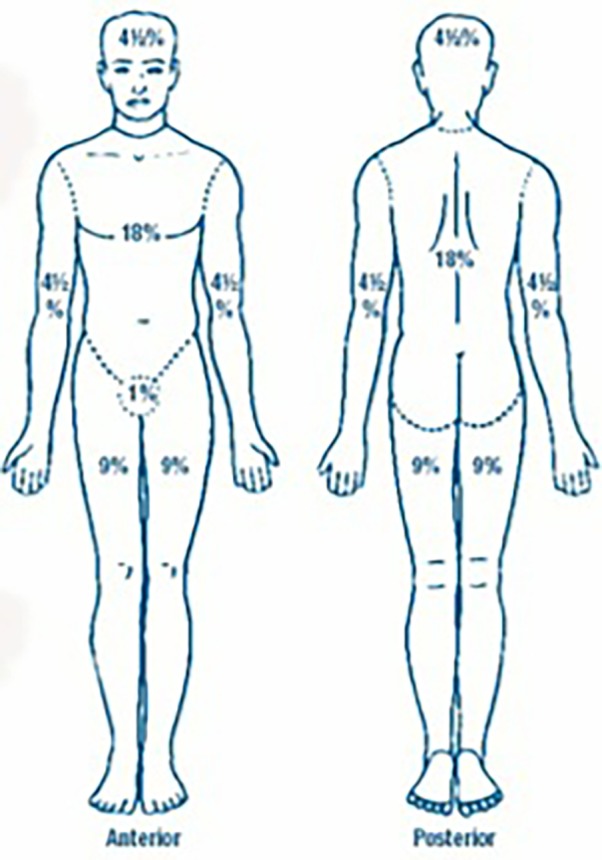
Rule of nines in burn assessment. (Copyright: ©2014 Feily.)
Figure 2.
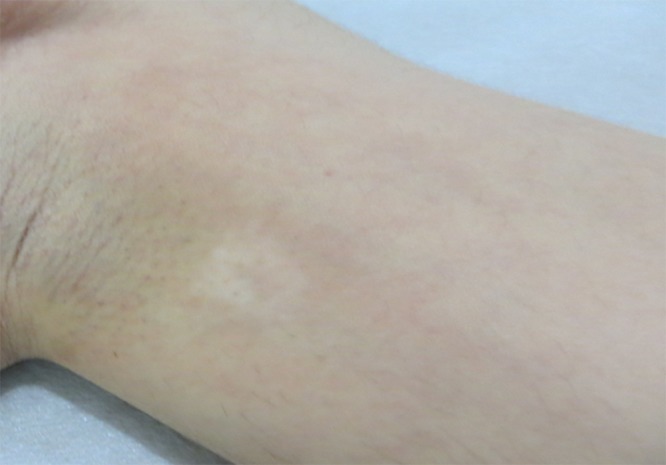
Hypopigmentation (including trichrome, and homogeneous lighter pigmentation). (Copyright: ©2014 Feily.)
Figure 3.
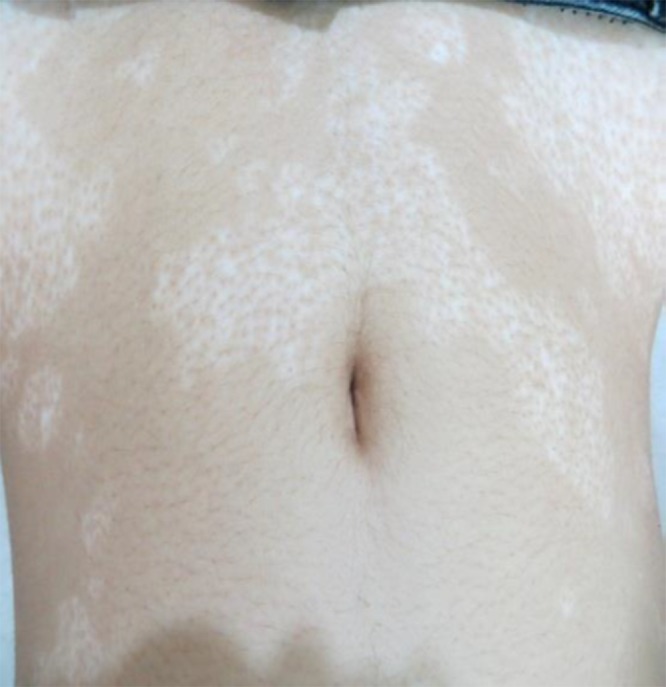
Complete depigmentation with black hair and perifollicular pigmentation. (Copyright: ©2014 Feily.)
Figure 4.
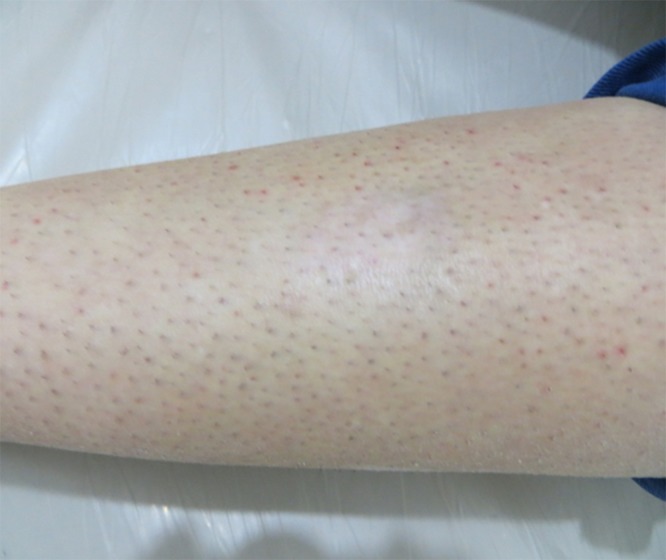
Complete depigmentation with black hair and without perifollicular pigmentation. (Copyright: ©2014 Feily.)
Figure 5.
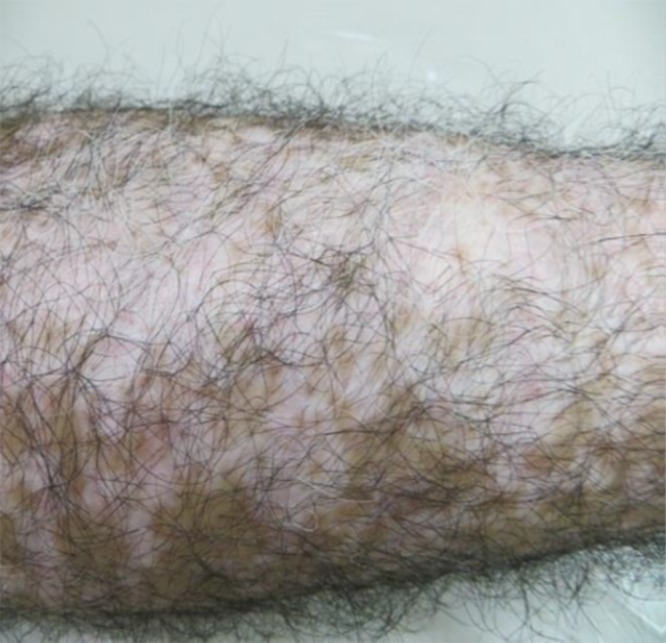
Complete depigmentation with compound of white and black hair with/without perifollicular pigmentation. (Copyright: ©2014 Feily.
Figure 6.
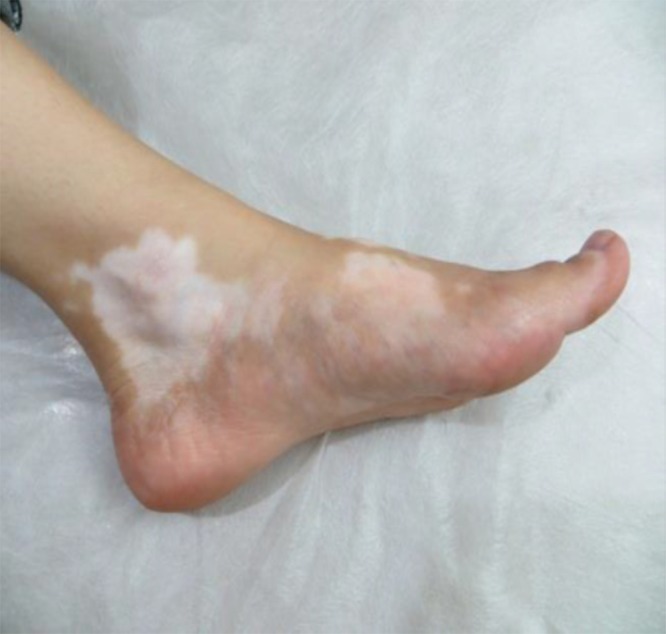
Complete depigmentation plus significant hair whitening. The area where hair does not exist normally, as in the extremities, is very resistant to treatment and placed in grade 5. (Copyright: ©2014 Feily.)
Notably an area where hair does not exist normally, like the extremities, is very resistant to treatment and placed in grade five. The total body VETI is calculated using the following formula that includes contributions from all body regions:
VETI score: (Percentage of head involvement × grade of tensity) + (Percentage of trunk involvement × grade of tensity) 4+ (Percentage of upper limbs involvement × grade of tensity) 2+ (Percentage of lower limbs involvement × grade of tensity) 4+ (Percentage of genitalia involvement × grade of tensity) 0.1
The coefficients reported in this formula are based on percent of skin surface by the rule of nines. Accordingly the coefficient of head is 1 (9:9=1), trunk and lower limb is 4 (36:9=4), upper limb is 2 (18:9=2) and genitalia is almost 0.1(1:9= 0.1).
Percentage of involvement: p
Tensity: T
- VETI:
The maximum score of VETI is 55.5.
For example, in Figure 3 if just the anterior of the body is involved, the VETI is calculated as follows:
Discussion
Vitiligo is an acquired depigmentary disorder characterized by the loss of functioning epidermal melanocytes [12] and affects more than 0.5–1% of the worldwide population with devastating psychological and social consequences [13,14]. Current lack of consensus on methods of assessment of this conundrum and inexistence of precise scoring to the extent that PASI does makes it principally impossible to evaluate the efficacy of new drugs or perform meta-analyses on the results of different studies of the same treatment [1,14]. Several scores have been proposed to surmount this problem and offer more accurate measures of disease severity indexes and inter-individual variations. Among the above scores designed for assessment of vitiligo, VASI provides a relatively simple method analogous to the Psoriasis Area Severity Index (PASI) and Vitiligo European Task Force (VETF) is a more complex system that incorporates three components of vitiligo: extent, stage and progression of disease, but these scores have some limitations with discrepancy in results and, unlike the PASI score do not make a constant total number [1,9,14]. Regarding the other two scores, it should be pointed out that the VIDA score is based on the patient’s opinion [10] resulting in eventual discrepancy as a result. PRI is a predictive index for repigmentation in non-segmental vitiligo [8] not a numerical index for measuring the extent and severity of vitiligo. Since the VIDA score is based on patient opinion, it makes sense to combine the VASI, VETF and some parts of the PRI systems and invent a system much more similar to the PASI score with constant total number and less inter-individual differences [10]. VETI score is a new treatment evaluation criteria and assessment method for vitiligo which can be easily handled in clinical practice. Although it is difficult to compare different modalities in vitiligo [14], we think VETI score is more like the PASI score for psoriasis, and unlike other vitiligo scores, produces a constant and reproducible number and would greatly help clinical research on vitiligo patients. Notably, it has the potential to be a source of any computed application for researchers who work on vitiligo patients. I hope advantages of this tool to be confirmed by future observations.
Footnotes
Funding: None.
References
- 1.Bhor U, Pande S. Scoring systems in dermatology. Indian J Dermatol Venereol Leprol. 2006;72:315–21. doi: 10.4103/0378-6323.26722. [DOI] [PubMed] [Google Scholar]
- 2.Pfütze M, Niedermeier A, Hertl M, Eming R. Introducing a novel Autoimmune Bullous Skin Disorder Intensity Score (ABSIS) in pemphigus. Eur J Dermatol. 2007;17:4–11. doi: 10.1684/ejd.2007.0090. [DOI] [PubMed] [Google Scholar]
- 3.Hamzavi I, Jain H, McLean D, Shapiro J, Zeng H, Lui H. Parametric modeling of narrowband UV-B phototherapy for vitiligo, using a novel quantitative tool: the Vitiligo Area Scoring Index. Arch Dermatol. 2004;140:677–683. doi: 10.1001/archderm.140.6.677. [DOI] [PubMed] [Google Scholar]
- 4.Taïeb A, Picardo M. The definition and assessment of vitiligo: a consensus report of the Vitiligo European Task Force. Pigment Cell Res. 2007;20:27–35. doi: 10.1111/j.1600-0749.2006.00355.x. [DOI] [PubMed] [Google Scholar]
- 5.PASI Calculator. http://pasi.corti.li/ Psoriasis Area Severity Index (PASI) Calculator (1.7.1). Accessed December 30, 2013.
- 6.Wong PC, Leung YY, Li EK, Tam LS. Measuring disease activity in psoriatic arthritis. Int J Rheumatol. 2012;2012:839425. doi: 10.1155/2012/839425. [DOI] [PMC free article] [PubMed] [Google Scholar]
- 7.Fredriksson T, Pettersson U. Severe psoriasis—oral therapy with a new retinoid. Dermatologica. 1978;157:238–44. doi: 10.1159/000250839. [DOI] [PubMed] [Google Scholar]
- 8.Benzekri L, Ezzedine K, Gauthier Y. Vitiligo Potential Repigmentation Index: a simple clinical score that might predict the ability of vitiligo lesions to repigment under therapy. Br J Dermatol. 2013;168:1143–6. doi: 10.1111/bjd.12147. [DOI] [PubMed] [Google Scholar]
- 9.Aydin F, Senturk N, Sahin B, et al. A practical method for the estimation of vitiligo surface area: a comparison between the point counting and digital planimetry techniques. Eur J Dermatol. 2007;17:30–2. doi: 10.1684/ejd.2007.0186. [DOI] [PubMed] [Google Scholar]
- 10.Njoo MD, Das PK, Bos JD, Westerhof W. Association of the Köbner phenomenon with disease activity and therapeutic responsiveness in vitiligo vulgaris. Arch Dermatol. 1999;135:407–13. doi: 10.1001/archderm.135.4.407. [DOI] [PubMed] [Google Scholar]
- 11.Wachtel TL, Berry CC, Wachtel EE, Frank HA. The inter-rater reliability of estimating the size of burns from various burn area chart drawings. Burns. 2000;26:156–70. doi: 10.1016/s0305-4179(99)00047-9. [DOI] [PubMed] [Google Scholar]
- 12.Feily A, Baktash D, Mohebbipour A, Feily A. Potential advantages of simvastatin as a novel anti-vitiligo arsenal. Eur Rev Med Pharmacol Sci. 2013;17:1982–3. [PubMed] [Google Scholar]
- 13.Feily A, Namazi MR. Silymarin as a potential novel addition to the limited anti-vitiligo weaponry: an untested hypothesis. Int J Clin Pharmacol Ther. 2011;49:467–8. doi: 10.5414/cp201557. [DOI] [PubMed] [Google Scholar]
- 14.Kawakami T, Hashimoto T. Disease severity indexes and treatment evaluation criteria in vitiligo. Dermatol Res Pract. 2011;2011:750342. doi: 10.1155/2011/750342. [DOI] [PMC free article] [PubMed] [Google Scholar]


